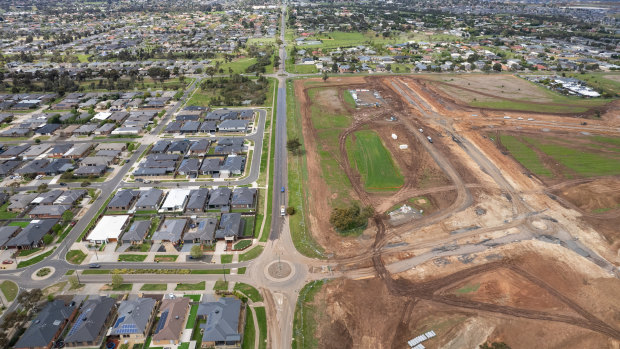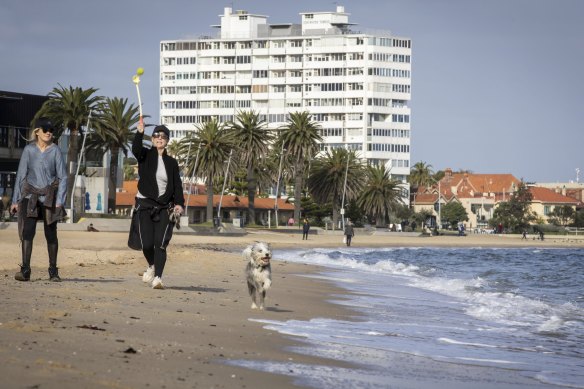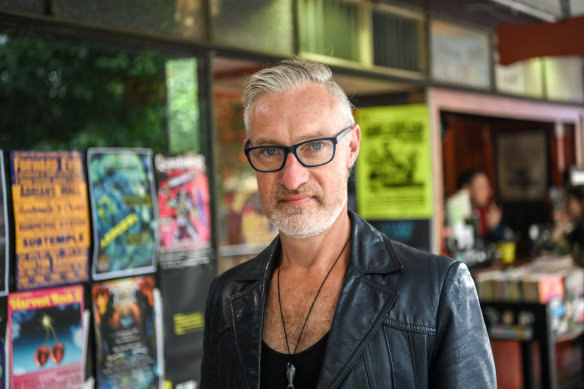Melburnians who live in medium-density parts of the city report higher levels of liveability than those in either the sky-scraper-dominated CBD or greenfield housing developments on the city’s fringe, a social research survey has found.
The consultants behind the 2023 Australian Liveability Census published on Thursday say the results should serve as a guide for the Victorian government as it embarks on its ambitious housing project to densify Melbourne’s inner and middle suburbs, and more than double the number of homes built each year to 80,000 per annum for the next decade.
More than 26,000 Australians – including more than 3000 Victorians – were surveyed by planning consultancy company Place Score between March and June this year and asked to score their local area on 50 different attributes. They included ease of moving around their suburbs, quality of local shops and open space, things to do at night and how socially connected they felt.
Each area is allocated a rating out of 100. PlaceScore says its methodology has been peer-reviewed by Macquarie University.
Three Victorian local government areas made the top 10 list for the country. Boroondara, which takes in the eastern suburbs of Kew, Camberwell and Hawthorn, came in fourth place with a score of 77, followed by Surf Coast Shire (77) on the Great Ocean Road in fifth place.
Port Phillip Council, which includes St Kilda, Middle Park and Elwood, came in ninth spot with a score of 76.
The survey also found that the top 10 densest LGAs across the country on average experienced 8 per cent better liveability than the national average.
Across metropolitan Melbourne – excluding the Mornington Peninsula – the top five most liveable council areas also included Bayside in the inner south-east, Darebin in the inner north and Stonnington in the inner east.
But there were differences between what people rated highly in those areas. The top contributing factor to Stonnington and Port Phillip’s score was “access to neighbourhood amenities”, while for Bayside, it was “physical comfort”.
Melbourne’s top five liveable local government areas and their top three reasons why (Source: Place Score)
- Boroondara (Local businesses that provide for daily needs, access to neighbourhood amenities, landscaping and natural elements)
- Port Phillip (Access to neighbourhood amenities, connectivity, spaces suitable for specific activities or special interests)
- Bayside (Physical comfort, access to neighbourhood amenities, local businesses that provide for daily needs)
- Darebin (Local businesses that provide for daily needs, access to neighbourhood amenities, welcoming to all people)
- Stonnington (Access to neighbourhood amenities, connectivity, local businesses that provide for daily needs)
For residents in Boroondara and Darebin, access to “local businesses that provide for daily needs” was the biggest factor in their high liveability score.
Kylie Legge, chief executive of Place Score and an urban planner, said both the national and Melbourne trends were similar: the best-performing local government areas tended to be older with mature trees and local strip shops and services, while the worst-performing were outer suburban areas with rapidly growing greenfield developments and often lagging infrastructure.

Growing greenfield housing developments in Melton in Melbourne’s outer west.Credit: Joe Armao
“Across metro Melbourne, the various regions are performing better than the national average everywhere except for in the western region [Wyndham, Melton, Brimbank, Maribyrnong, Hobsons Bay], which is unfortunately performing significantly lower,” she said.
Liveability scores in the west ranged from 70 to 75 per cent in Hobsons Bay, which includes the bayside suburb of Williamstown, to 55 to 60 per cent in Wyndham, which reaches the western fringe of the city.
“That is always concerning for us when we see an area where the people themselves are really unsatisfied with what their neighbourhoods are actually providing for them,” Legge said.
“It also happens to be some of the fastest-growing areas where a huge proportion of housing is planned. So there’s a real disconnect there between putting as many lives as possible in the place that is currently the most unliveable.”
The median price for a three-bedroom home in Kew in Boroondara is $2.1 million, in Middle Park in Port Phillip council it is $2.46 million – while in Melton in the outer west it is $449,000, according to Domain.
Australia’s most livable local government areas
- Subiaco (WA)
- Lane Cove (NSW)
- Hunters Hill (NSW)
- Boroondara (VIC)
- Surf Coast (VIC)
- Vincent (WA)
- North Sydney (NSW)
- Cambridge (WA)
- Port Phillip (VIC)
- Noosa (QLD)
Source: Place Score
The survey asked participants how likely they would be to recommend their area to others to live.
“In metropolitan Melbourne, only people living in the western region are unwilling to recommend that place as a place to live,” Legge said.
She said the data should be applied to the state government’s 10-year plan to rectify the imbalance of homes being built in established areas of Melbourne and those in greenfield developments.
Her firm’s research, she argued, showed it was clear that it was not the highest skyscraper-dominated areas nor sprawling, car-dependent greenfield developments where people were most content but somewhere in between; neighbourhoods with multiple local centres, parks, green streets and a mix of apartment buildings from three to 12 storeys, terraces, townhouses and some larger stand-alone homes, too.

St Kilda Beach foreshore. Port Phillip Council has made it onto the top 10 local government areas in the country for liveability, as rated by residents.Credit: Darrian Traynor
“Everything they’re asking for us is all good stuff – there’s nothing crazy. We want green, walkable, compact and well-maintained neighbourhoods,” she said.
Kew local Winston Todd, 49, has lived in the Boroondara area for the vast majority of his life and says he’s never had cause to live elsewhere because of how good the amenity is.
“I’m a parent now. So there’s great schools around here. Heaps of great public parks. We’ve got a river nearby and that’s a fabulous resource, terrific transport,” he said.

Boroondara local of 46 years Winston Todd at a cafe in Glenferrie.Credit: Justin McManus
Boroondara Mayor Felicity Sinfield said she was proud of her council being the most liveable in Melbourne, and it was a “timely reminder” of the benefit of local council input to planning.
Camberwell in Boroondara is one of 10 “key activity centres” where the state government intends 60,000 new homes to be built.
“We’ve got lots of features I would encourage the state government to look at as they are building up other areas – simple things like wider, tree-lined streets that give us amenity,” Sinfield said.
Get the day’s breaking news, entertainment ideas and a long read to enjoy. Sign up to receive our Evening Edition newsletter here.
https://news.google.com/rss/articles/CBMiiAFodHRwczovL3d3dy50aGVhZ2UuY29tLmF1L25hdGlvbmFsL3ZpY3RvcmlhL21lbGJvdXJuZS1zLW1vc3QtbGl2ZWFibGUtc3VidXJicy1hcmVuLXQtaW4tdGhlLWNiZC1vci10aGUtb3V0ZXItZnJpbmdlLTIwMjMxMDMwLXA1ZWczbC5odG1s0gGIAWh0dHBzOi8vYW1wLnRoZWFnZS5jb20uYXUvbmF0aW9uYWwvdmljdG9yaWEvbWVsYm91cm5lLXMtbW9zdC1saXZlYWJsZS1zdWJ1cmJzLWFyZW4tdC1pbi10aGUtY2JkLW9yLXRoZS1vdXRlci1mcmluZ2UtMjAyMzEwMzAtcDVlZzNsLmh0bWw?oc=5
2023-11-01 18:00:00Z
2569504258
Bagikan Berita Ini














0 Response to "Melbourne’s most liveable suburbs aren’t in the CBD or the outer fringe - The Age"
Post a Comment